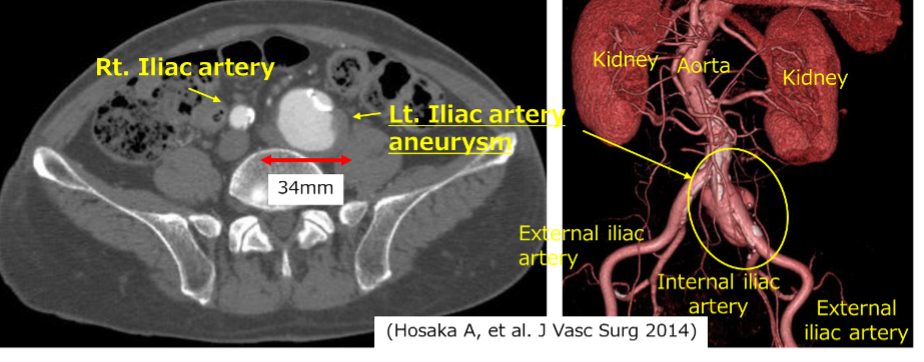How many centimeters of an iliac aneurysm should be critical?
What is an iliac aneurysm?
The iliac arteries divide the aorta to the left and right at the level of the navel. These are called common iliac arteries. They are then divided into the external iliac artery (flowing toward the foot) and the internal iliac artery (flowing toward the pelvis). Aneurysms of these arteries have a risk of rupture, like other aneurysms. The figure below is an image of a case of an iliac aneurysm published by Hosaka et al. from our department.)

How many centimeters of an iliac aneurysm should be critical?
The diameter of the normal aorta is approximately 2 cm, and 5 cm (roughly 2.5 times) is considered as the threshold for surgical intervention in Japan.
So, what about the iliac arteries? The diameter of the common iliac artery is approximately 1 cm on average. Considering the threshold for AAA, approximately 3 cm has conventionally been the threshold for surgical intervention. In our department, we have decided that iliac aneurysms > 3 cm in diameter are indicated for surgery without any convincing evidence.
However, some skilled surgeons often claim that they had never seen a rupture at 3 cm, or that 3 cm was too small for surgical indications. Therefore, we decided to review past reports and search for the optimal surgically applicable diameter.
Review of the reports regarding iliac aneurysm
There are five reports that contribute evidence to our review (Surveyed by Makino Y, in our department).
1) Analysis of iliac aneurysms in 50 cases and 71 lesions from 1970 to 1982. The average diameter was 4.7 cm. Nineteen cases were followed up, with an average aneurysm diameter of 3.4 cm. The average growth rate was 4 mm per year. There were 5 symptomatic cases (possible rupture), ranging from 3 to 20 cm (McCready et al., Surgery, 1983).
2) Analysis of 33 lesions in 25 cases from 1977 to 1993. There were 14 surgical cases with an average aneurysm diameter of 3.8 cm. There were 5 emergency cases (rupture) with aneurysm diameter ranging from 3 cm to 8 cm. They observed the cases under 2.5 cm and found no case of enlargement (Casirajan et al., Cardiovasc Surg, 1998)
3) Seventy-two lesions in 55 cases were reported from 1972 to 1985. The average aneurysm diameter was 5.5 cm, and there were 9 cases of rupture, ranging from 3.5 cm to 18 cm (Richardson et al., J Vasc Surg 1988).
These are old reports, and the accuracy of measurement of the diameter of the aneurysm with their imaging modalities should be low. However, the minimum value for ruptured cases is 3.5 cm, which is shown in the third report. Considering this case of rupture, it takes courage to set the threshold value to 4 cm.
4) A total of 189 cases and 323 lesions were reported from 1990 to 1999. This report was relatively new and had a large number of cases. The average diameter was 2.34 cm. The expansion speed increased when the diameter of the aneurysm was 3 cm (1−2.6 mm/year) (Santilli et al., J Vasc Surg, 2000).
This report supported the validity of the conventional threshold of 3 cm.
5) A questionnaire sent to 284 British vascular surgeons asking when to start surgery or surveillance. Approximately 24% of the surgeons operated at 3 cm, and most surgeons operated at 4 cm (64%). There were some opinions that the follow-up period should be shortened if the aneurysm exceeded 2.6 cm (Williams et al., Ann R Coll Surg Engl, 2014).
Although it was just a questionnaire, it was revealed that 3 cm was a minority in the real world.
In summary, cases of aneurysm rupture exist from 3.5 cm, and the majority of surgeons set the threshold at 4 cm, although the expansion speed increased beyond 3 cm. Therefore, we changed the threshold of surgical intervention for iliac artery aneurysms from 3 cm to 3.5 cm.
In the guidelines of the European Society of Vascular Surgery published in 2019, the threshold was 3.5 cm, which is the same as the result of our review. (Fig.2)

